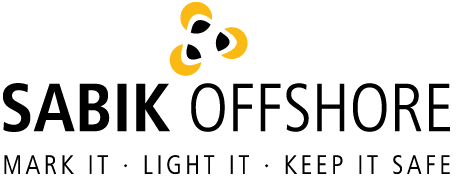Fog signals are an essential feature on an offshore wind farm
In times of low visibility, fog signals are an essential feature on an offshore wind farm, alerting mariners that they are close to danger and that an obstruction is in the area. They are an important component for maintaining safety around the site.
Fog signals are typically positioned on significant peripheral structures of an offshore wind farm and they must emit a beam of sound outwards to at least 2NM.
Traditionally, a visibility meter mounted next to the fog signal monitors the atmosphere and triggers the fog signal if there is low visibility in the immediate area. The USA uses a different technology, called MRASS. The Mariner Activated Sound Signal receives a trigger from a vessel operator over VHF radio which then turns on the fog signal.
Sabik Offshore’s Innovations in Fog Signal Technology
Before developing our own fog signal, the first fog signal we used was from the Oil & Gas sector. While this was the best option available on the market at the time, it was not designed with the requirements of offshore wind farms in mind.
Sabik Offshore searched far and wide to find a suitable alternative to the fog signals on the market, but were unable to find one. Existing fog signals were bulky and designed for the Oil & Gas industry. All were big and extremely heavy. The equipment had to sit on a specially-constructed platform. If it was going to be retrofitted or needed servicing, this would require a boat and a crane, creating additional expense.
Therefore, we took it upon ourselves to build a new fog signal more suited for offshore wind turbines. This led us to develop the SeaMark NAi FS02 Fog Signal, our lightweight, easy-to-handle and easy-to-install fog signal, designed specifically to cater to the offshore wind industry.
In order to ensure complete coverage around an offshore wind farm, here at Sabik Offshore we also developed our own fog signal simulation software, the only technology of its kind on the market. This ensures optimal placement of the fog signals within the wind farm.
You are currently viewing a placeholder content from Default. To access the actual content, click the button below. Please note that doing so will share data with third-party providers.
More InformationThe Design Process
In creating our own fog signal, we made significant design changes.
We teamed up with the IFAA (Institute for Acoustic and Audio Technique), working with their acoustic experts to create the FS02 NAi SeaMark Fog Signal. Each part, on its own, emits a signal of just 0.5NM but – joined together and synchronized – we were able to take advantage of the laws of physics, as the combined frequency covers the required 2NM.
Furthermore, the directional design of the fog signals, each covering a range of approx. 115°, means that the sound is emitted within a specified area, minimizing conflict with any other sound waves.
We wanted to create something which a service technician could handle by themselves, so its design is lightweight and easy to mount.
The fog signal is made of two separate parts which are then combined, each weighing less than 20kg, a design feature which also makes installation cheaper and easier: the fog signal parts can be installed by an engineer who can easily carry them, instead of requiring a crane to lift heavy components into place.
The FS02 Fog Signal is part of our SeaMark range, satisfies IALA recommendation G1162, and is currently being implemented worldwide.
We are proud of using our expertise to develop solutions specifically for the offshore wind industry. Our products help to make offshore wind farms a safer environment for everyone.
We are Sabik Offshore, your experts in lighting and marking offshore wind farms.
